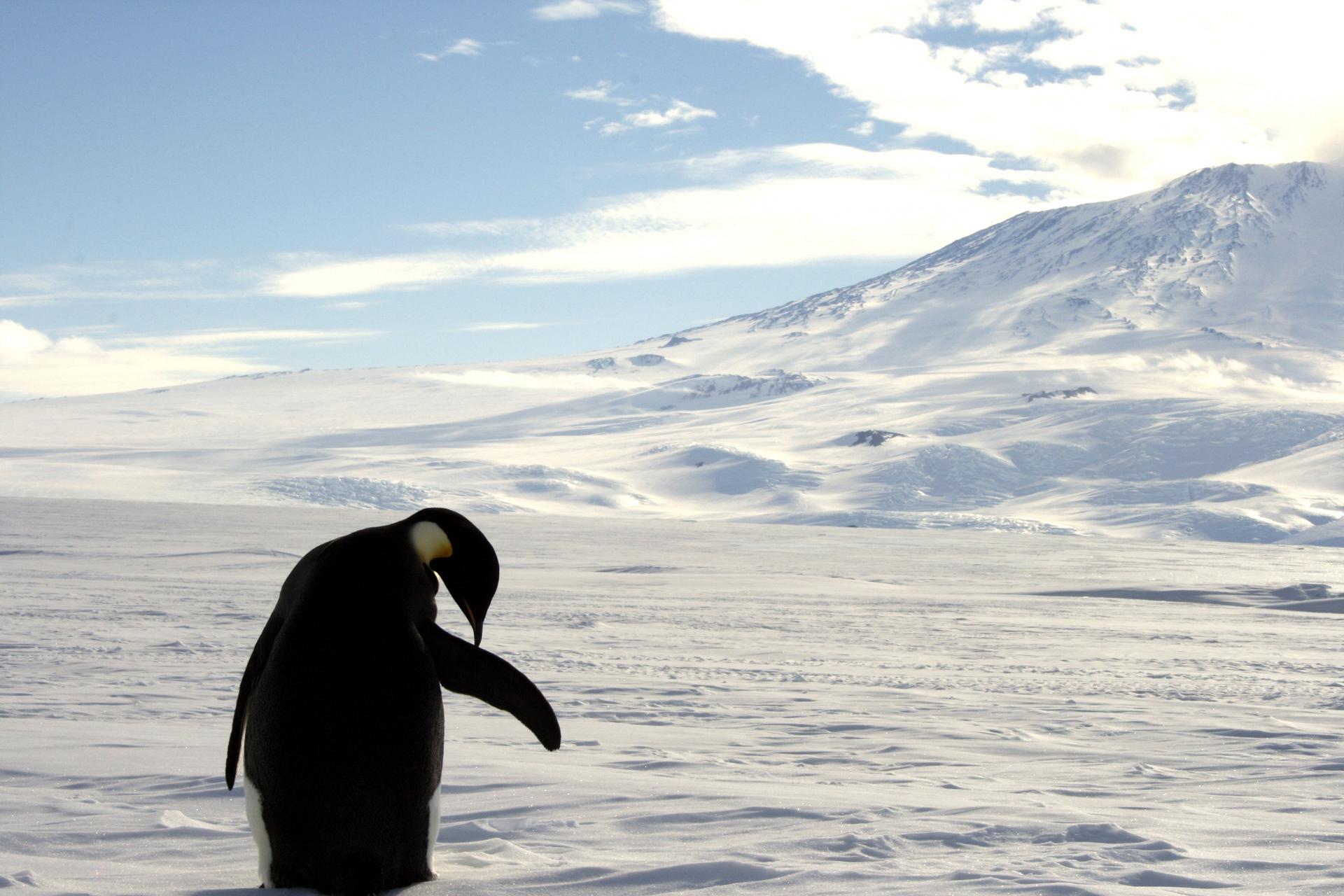How do we process doom-and-gloom climate news? How should we?
A foraging Emperor penguin preens on snow-covered sea ice around the base of the active volcano Mount Erebus, near McMurdo Station, the largest US Science base in Antarctica, Dec. 9, 2006.
Frightening stories about climate change seem to come in a never-ending wave these days.
In just the past week, we’ve learned that Antarctica is melting three times faster than it was a decade ago, rising seas might flood more than 300,000 US homes twice a month within decades, and that India is facing the worst water crisis in its history.
How do our brains respond to this onslaught of negative news?
Not well.
“Climate change has all the hallmarks of an issue which is difficult for people to engage with psychologically,” says Lorraine Whitmarsh, professor of environmental psychology at the University of Cardiff in Wales.
People perceive the risks of climate change “as both considerably uncertain and also as being mostly in the future and geographically distant, all factors that lead people to discount them,” according to a 2009 American Psychological Association report on the topic.
In other words, the worst impacts of climate change feel far away — in both time and place — to many Americans. So while it will increasingly impact all of us, every day, it’s hard for us to get worked up about it.
So do news stories with frightening projections about the future prod us to action, or make us stick our heads in the sand?
It’s a debated topic in psychology, and some recent research suggests there’s not enough evidence to empirically say whether or not “arousing fear” is an effective way to communicate the risks of climate change. But other psychologists argue we know enough to say scare tactics don’t work when it comes to engaging the public.
“What we know from psychological studies is that if you overuse fear-inducing imagery, what you get is fear and guilt in people, and this makes people more passive, which counteracts engagement,” Norwegian psychologist and author of “What We Think About When We Try Not To Think About Global Warming,” Per Espen Stoknes, told YaleEnvironment360.
So what does work in effectively communicating the risks of climate change?
Making it personal, Whitmarsh says. “Talk to people about the impacts of climate change on things that are important to them, things that they value,” Whitmarsh tells The World. “They may be family, or their local area, or objects or areas that are important to them, rather than talking about distant regions.”
When it comes to changing behaviors that impact the environment, Whitmarsh has found it’s often more effective not to raise the issue of climate change at all.
“If you want people to save energy, reduce the amount of meat they’re consuming, reduce the amount of flights they’re taking, for example, you don’t necessarily need to make an environmental or climate change argument to get them to do that,” Whitmarsh says.
Explain the economic argument for using less energy, for example, or the health benefits of eating less meat. Some research has shown, for example, that real-time energy usage readings help people use less energy.
“Emphasizing those (personal benefits) when you’re communicating and trying to persuade people to change their behaviour is more likely to be effective,” Whitmarsh says.
Accentuate the positive
It’s a tactic climate scientist Peter Kalmus takes in his book, “Being the Change: Live Well and Spark a Climate Revolution.”
Kalmus writes about his experience cutting his carbon footprint to a tenth of what it once was by giving up flying and eating meat, taking up biking, and scavenging and growing his own food. These changes not only helped him live more sustainably, it also made him happier and feel more connected to his community.
“There was a lot about it that I liked, that I would do even if there wasn’t a climate emergency,” Kalmus says, including biking, gardening, and converting his car to run on waste vegetable oil. “I really enjoyed all of these things.”
Kalmus, a climate scientist at NASA’s Jet Propulsion Laboratory in California who speaks on his own behalf and not for NASA, tells The World that he had an “unpleasant wake-up call” when he started learning more about climate change and decided to switch his field of study from astrophysics to atmospheric science.
“I was kind of shaking people by the proverbial lapels and telling them ‘We need to stop burning fossil fuels,’” Kalmus said. “And then I realized ‘Hey, I’m not actually doing that myself.’ So maybe I can reduce my own use of fossil fuel.”
About eight years ago he sat down to take stock of his own personal CO2 emissions. He found that flying produced about three-quarters of his 20-ton annual carbon footprint, and in 2012, he gave up flying. He still travels with his wife and kids — they just opt for trips within California and, about once a year, drive their bio-fueled car or take the train to visit family in Chicago, camping along the way.
Kalmus recognizes that not everyone can easily bike to work, or give up flying altogether.
But he says an easy first step for those interested in cutting their carbon footprint is sitting down to do a personal CO2 audit.
“Figure out how your actions are connected to CO2,” he says, can help you pinpoint the biggest steps you can take to reduce your CO2 emissions. “So hopefully people can find something that makes them happier and also reduces their footprint. And then that’s a sustainable change, and hopefully they’ll be eager to try taking the second step.”
One person can’t fight climate change alone. But Kalmus hopes he’ll be an example others can follow.
“What I’m doing is trying to push for a cultural shift,“ Kalmus says. “As more and more people start demanding alternatives to the fossil-fueled infrastructure, I think the systems will start to catch up.”
